Market Entry Strategies: Evaluating Options for Global Expansion
VerifiedAdded on 2021/11/18
|6
|2324
|432
Report
AI Summary
This report provides a comprehensive overview of various market entry strategies employed by firms to engage in foreign business. It delves into strategies such as direct exporting, licensing, joint ventures, franchising, and foreign direct investment (FDI). The report discusses the advantages and disadvantages of each strategy, considering factors like cost, control, risk, and potential for profit. It explores the intricacies of each approach, including the mechanics of direct exporting, the contractual aspects of licensing, the collaborative nature of joint ventures, the operational aspects of franchising, and the investment implications of FDI. The analysis includes an examination of the benefits such as increased revenue, market access, and brand protection, as well as the challenges like high costs, logistical difficulties, and potential for conflicts. The report emphasizes the importance of selecting the right strategy based on a company's specific goals, market conditions, and risk tolerance, offering a valuable resource for understanding the complexities of global market entry.
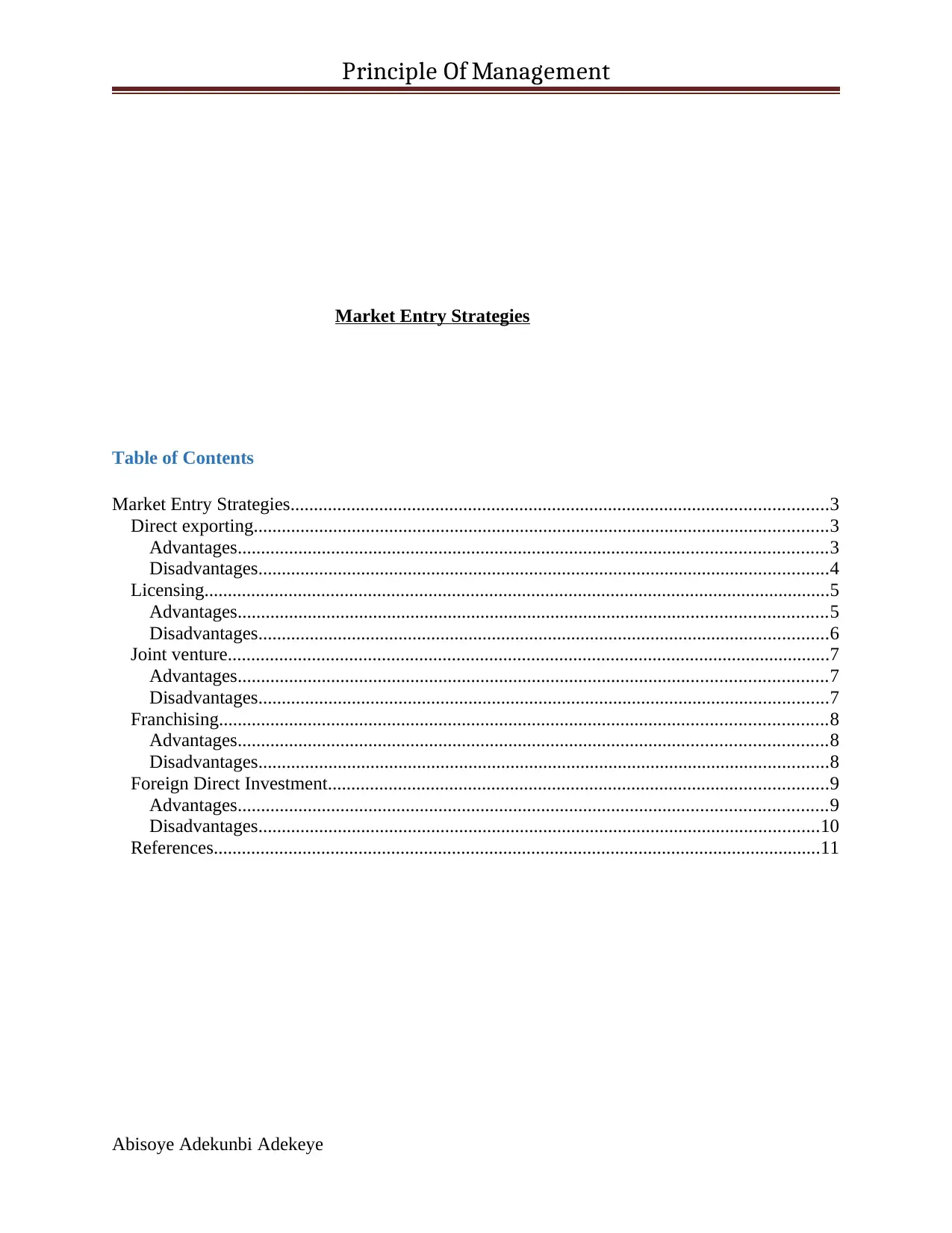
Principle Of Management
Market Entry Strategies
Table of Contents
Market Entry Strategies...................................................................................................................3
Direct exporting...........................................................................................................................3
Advantages..............................................................................................................................3
Disadvantages..........................................................................................................................4
Licensing......................................................................................................................................5
Advantages..............................................................................................................................5
Disadvantages..........................................................................................................................6
Joint venture.................................................................................................................................7
Advantages..............................................................................................................................7
Disadvantages..........................................................................................................................7
Franchising..................................................................................................................................8
Advantages..............................................................................................................................8
Disadvantages..........................................................................................................................8
Foreign Direct Investment...........................................................................................................9
Advantages..............................................................................................................................9
Disadvantages........................................................................................................................10
References..................................................................................................................................11
Abisoye Adekunbi Adekeye
Market Entry Strategies
Table of Contents
Market Entry Strategies...................................................................................................................3
Direct exporting...........................................................................................................................3
Advantages..............................................................................................................................3
Disadvantages..........................................................................................................................4
Licensing......................................................................................................................................5
Advantages..............................................................................................................................5
Disadvantages..........................................................................................................................6
Joint venture.................................................................................................................................7
Advantages..............................................................................................................................7
Disadvantages..........................................................................................................................7
Franchising..................................................................................................................................8
Advantages..............................................................................................................................8
Disadvantages..........................................................................................................................8
Foreign Direct Investment...........................................................................................................9
Advantages..............................................................................................................................9
Disadvantages........................................................................................................................10
References..................................................................................................................................11
Abisoye Adekunbi Adekeye
Paraphrase This Document
Need a fresh take? Get an instant paraphrase of this document with our AI Paraphraser
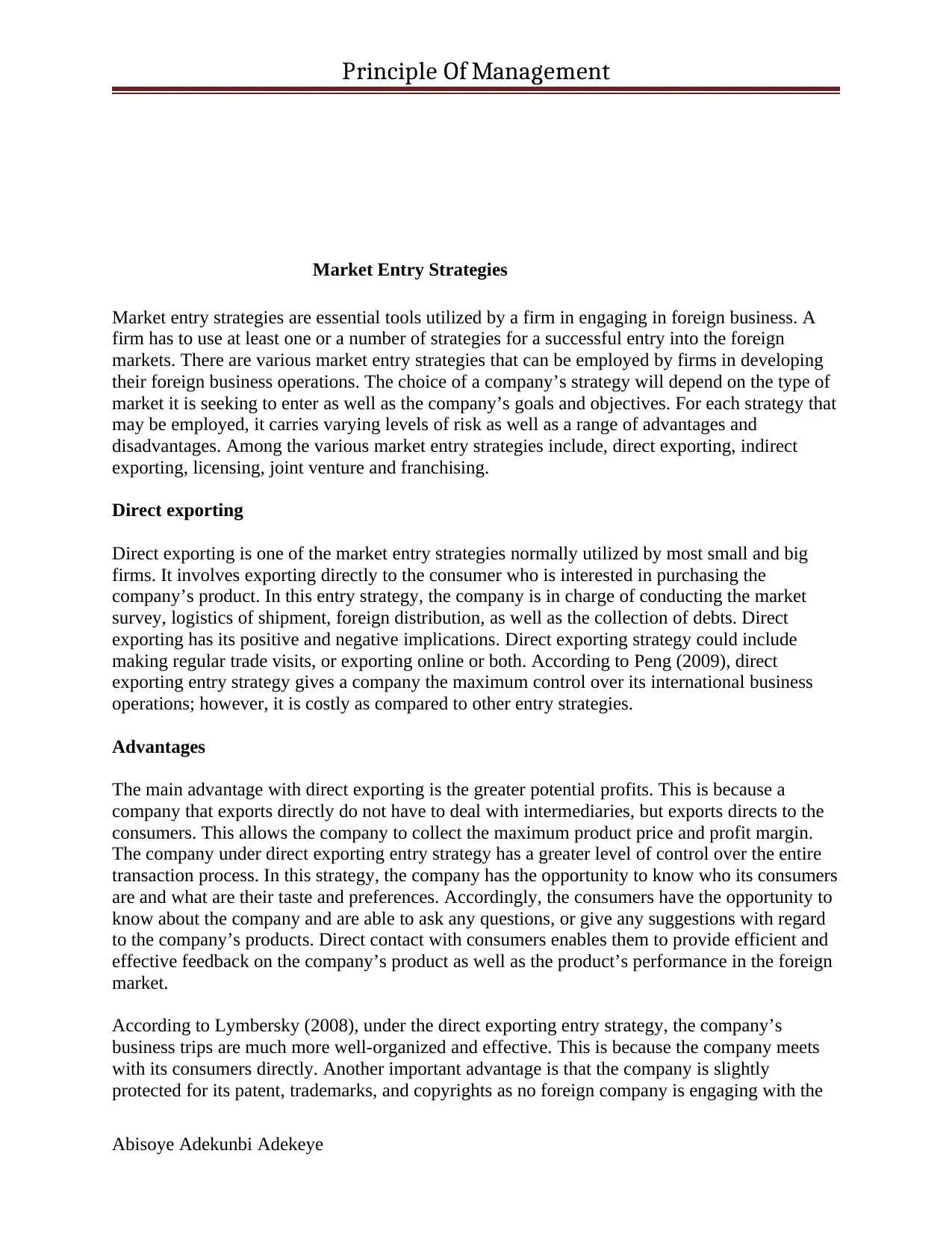
Principle Of Management
Market Entry Strategies
Market entry strategies are essential tools utilized by a firm in engaging in foreign business. A
firm has to use at least one or a number of strategies for a successful entry into the foreign
markets. There are various market entry strategies that can be employed by firms in developing
their foreign business operations. The choice of a company’s strategy will depend on the type of
market it is seeking to enter as well as the company’s goals and objectives. For each strategy that
may be employed, it carries varying levels of risk as well as a range of advantages and
disadvantages. Among the various market entry strategies include, direct exporting, indirect
exporting, licensing, joint venture and franchising.
Direct exporting
Direct exporting is one of the market entry strategies normally utilized by most small and big
firms. It involves exporting directly to the consumer who is interested in purchasing the
company’s product. In this entry strategy, the company is in charge of conducting the market
survey, logistics of shipment, foreign distribution, as well as the collection of debts. Direct
exporting has its positive and negative implications. Direct exporting strategy could include
making regular trade visits, or exporting online or both. According to Peng (2009), direct
exporting entry strategy gives a company the maximum control over its international business
operations; however, it is costly as compared to other entry strategies.
Advantages
The main advantage with direct exporting is the greater potential profits. This is because a
company that exports directly do not have to deal with intermediaries, but exports directs to the
consumers. This allows the company to collect the maximum product price and profit margin.
The company under direct exporting entry strategy has a greater level of control over the entire
transaction process. In this strategy, the company has the opportunity to know who its consumers
are and what are their taste and preferences. Accordingly, the consumers have the opportunity to
know about the company and are able to ask any questions, or give any suggestions with regard
to the company’s products. Direct contact with consumers enables them to provide efficient and
effective feedback on the company’s product as well as the product’s performance in the foreign
market.
According to Lymbersky (2008), under the direct exporting entry strategy, the company’s
business trips are much more well-organized and effective. This is because the company meets
with its consumers directly. Another important advantage is that the company is slightly
protected for its patent, trademarks, and copyrights as no foreign company is engaging with the
Abisoye Adekunbi Adekeye
Market Entry Strategies
Market entry strategies are essential tools utilized by a firm in engaging in foreign business. A
firm has to use at least one or a number of strategies for a successful entry into the foreign
markets. There are various market entry strategies that can be employed by firms in developing
their foreign business operations. The choice of a company’s strategy will depend on the type of
market it is seeking to enter as well as the company’s goals and objectives. For each strategy that
may be employed, it carries varying levels of risk as well as a range of advantages and
disadvantages. Among the various market entry strategies include, direct exporting, indirect
exporting, licensing, joint venture and franchising.
Direct exporting
Direct exporting is one of the market entry strategies normally utilized by most small and big
firms. It involves exporting directly to the consumer who is interested in purchasing the
company’s product. In this entry strategy, the company is in charge of conducting the market
survey, logistics of shipment, foreign distribution, as well as the collection of debts. Direct
exporting has its positive and negative implications. Direct exporting strategy could include
making regular trade visits, or exporting online or both. According to Peng (2009), direct
exporting entry strategy gives a company the maximum control over its international business
operations; however, it is costly as compared to other entry strategies.
Advantages
The main advantage with direct exporting is the greater potential profits. This is because a
company that exports directly do not have to deal with intermediaries, but exports directs to the
consumers. This allows the company to collect the maximum product price and profit margin.
The company under direct exporting entry strategy has a greater level of control over the entire
transaction process. In this strategy, the company has the opportunity to know who its consumers
are and what are their taste and preferences. Accordingly, the consumers have the opportunity to
know about the company and are able to ask any questions, or give any suggestions with regard
to the company’s products. Direct contact with consumers enables them to provide efficient and
effective feedback on the company’s product as well as the product’s performance in the foreign
market.
According to Lymbersky (2008), under the direct exporting entry strategy, the company’s
business trips are much more well-organized and effective. This is because the company meets
with its consumers directly. Another important advantage is that the company is slightly
protected for its patent, trademarks, and copyrights as no foreign company is engaging with the
Abisoye Adekunbi Adekeye
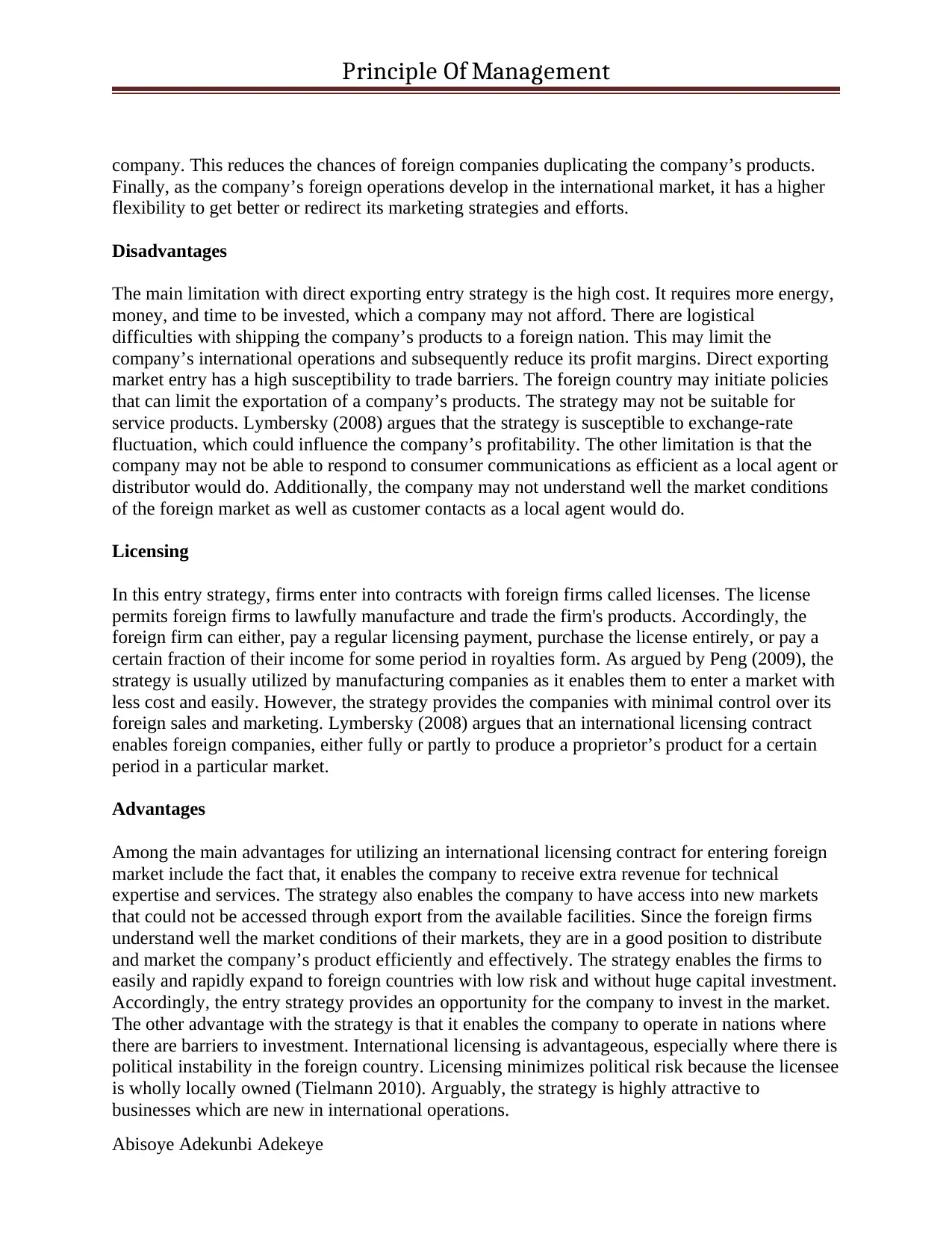
Principle Of Management
company. This reduces the chances of foreign companies duplicating the company’s products.
Finally, as the company’s foreign operations develop in the international market, it has a higher
flexibility to get better or redirect its marketing strategies and efforts.
Disadvantages
The main limitation with direct exporting entry strategy is the high cost. It requires more energy,
money, and time to be invested, which a company may not afford. There are logistical
difficulties with shipping the company’s products to a foreign nation. This may limit the
company’s international operations and subsequently reduce its profit margins. Direct exporting
market entry has a high susceptibility to trade barriers. The foreign country may initiate policies
that can limit the exportation of a company’s products. The strategy may not be suitable for
service products. Lymbersky (2008) argues that the strategy is susceptible to exchange-rate
fluctuation, which could influence the company’s profitability. The other limitation is that the
company may not be able to respond to consumer communications as efficient as a local agent or
distributor would do. Additionally, the company may not understand well the market conditions
of the foreign market as well as customer contacts as a local agent would do.
Licensing
In this entry strategy, firms enter into contracts with foreign firms called licenses. The license
permits foreign firms to lawfully manufacture and trade the firm's products. Accordingly, the
foreign firm can either, pay a regular licensing payment, purchase the license entirely, or pay a
certain fraction of their income for some period in royalties form. As argued by Peng (2009), the
strategy is usually utilized by manufacturing companies as it enables them to enter a market with
less cost and easily. However, the strategy provides the companies with minimal control over its
foreign sales and marketing. Lymbersky (2008) argues that an international licensing contract
enables foreign companies, either fully or partly to produce a proprietor’s product for a certain
period in a particular market.
Advantages
Among the main advantages for utilizing an international licensing contract for entering foreign
market include the fact that, it enables the company to receive extra revenue for technical
expertise and services. The strategy also enables the company to have access into new markets
that could not be accessed through export from the available facilities. Since the foreign firms
understand well the market conditions of their markets, they are in a good position to distribute
and market the company’s product efficiently and effectively. The strategy enables the firms to
easily and rapidly expand to foreign countries with low risk and without huge capital investment.
Accordingly, the entry strategy provides an opportunity for the company to invest in the market.
The other advantage with the strategy is that it enables the company to operate in nations where
there are barriers to investment. International licensing is advantageous, especially where there is
political instability in the foreign country. Licensing minimizes political risk because the licensee
is wholly locally owned (Tielmann 2010). Arguably, the strategy is highly attractive to
businesses which are new in international operations.
Abisoye Adekunbi Adekeye
company. This reduces the chances of foreign companies duplicating the company’s products.
Finally, as the company’s foreign operations develop in the international market, it has a higher
flexibility to get better or redirect its marketing strategies and efforts.
Disadvantages
The main limitation with direct exporting entry strategy is the high cost. It requires more energy,
money, and time to be invested, which a company may not afford. There are logistical
difficulties with shipping the company’s products to a foreign nation. This may limit the
company’s international operations and subsequently reduce its profit margins. Direct exporting
market entry has a high susceptibility to trade barriers. The foreign country may initiate policies
that can limit the exportation of a company’s products. The strategy may not be suitable for
service products. Lymbersky (2008) argues that the strategy is susceptible to exchange-rate
fluctuation, which could influence the company’s profitability. The other limitation is that the
company may not be able to respond to consumer communications as efficient as a local agent or
distributor would do. Additionally, the company may not understand well the market conditions
of the foreign market as well as customer contacts as a local agent would do.
Licensing
In this entry strategy, firms enter into contracts with foreign firms called licenses. The license
permits foreign firms to lawfully manufacture and trade the firm's products. Accordingly, the
foreign firm can either, pay a regular licensing payment, purchase the license entirely, or pay a
certain fraction of their income for some period in royalties form. As argued by Peng (2009), the
strategy is usually utilized by manufacturing companies as it enables them to enter a market with
less cost and easily. However, the strategy provides the companies with minimal control over its
foreign sales and marketing. Lymbersky (2008) argues that an international licensing contract
enables foreign companies, either fully or partly to produce a proprietor’s product for a certain
period in a particular market.
Advantages
Among the main advantages for utilizing an international licensing contract for entering foreign
market include the fact that, it enables the company to receive extra revenue for technical
expertise and services. The strategy also enables the company to have access into new markets
that could not be accessed through export from the available facilities. Since the foreign firms
understand well the market conditions of their markets, they are in a good position to distribute
and market the company’s product efficiently and effectively. The strategy enables the firms to
easily and rapidly expand to foreign countries with low risk and without huge capital investment.
Accordingly, the entry strategy provides an opportunity for the company to invest in the market.
The other advantage with the strategy is that it enables the company to operate in nations where
there are barriers to investment. International licensing is advantageous, especially where there is
political instability in the foreign country. Licensing minimizes political risk because the licensee
is wholly locally owned (Tielmann 2010). Arguably, the strategy is highly attractive to
businesses which are new in international operations.
Abisoye Adekunbi Adekeye
⊘ This is a preview!⊘
Do you want full access?
Subscribe today to unlock all pages.

Trusted by 1+ million students worldwide
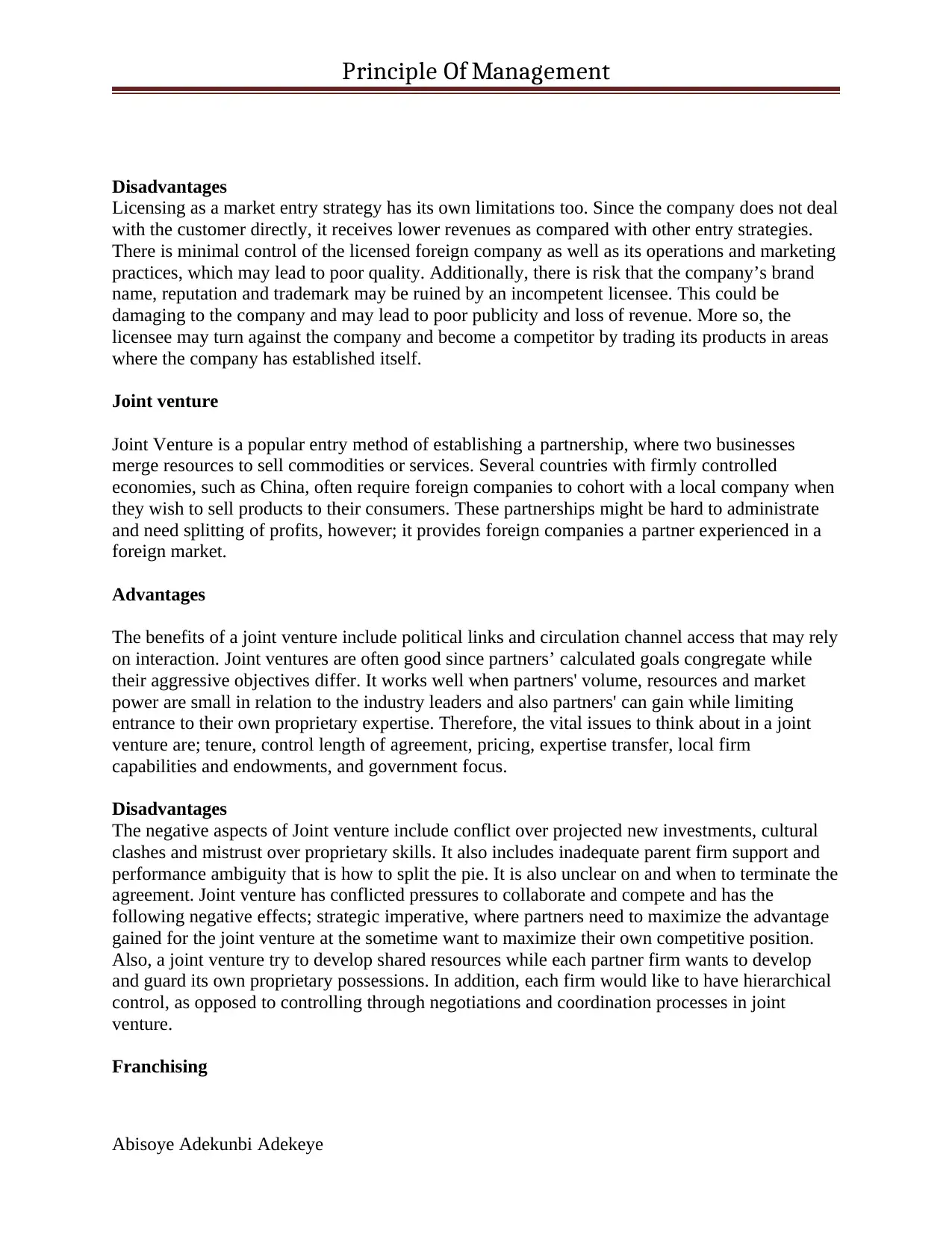
Principle Of Management
Disadvantages
Licensing as a market entry strategy has its own limitations too. Since the company does not deal
with the customer directly, it receives lower revenues as compared with other entry strategies.
There is minimal control of the licensed foreign company as well as its operations and marketing
practices, which may lead to poor quality. Additionally, there is risk that the company’s brand
name, reputation and trademark may be ruined by an incompetent licensee. This could be
damaging to the company and may lead to poor publicity and loss of revenue. More so, the
licensee may turn against the company and become a competitor by trading its products in areas
where the company has established itself.
Joint venture
Joint Venture is a popular entry method of establishing a partnership, where two businesses
merge resources to sell commodities or services. Several countries with firmly controlled
economies, such as China, often require foreign companies to cohort with a local company when
they wish to sell products to their consumers. These partnerships might be hard to administrate
and need splitting of profits, however; it provides foreign companies a partner experienced in a
foreign market.
Advantages
The benefits of a joint venture include political links and circulation channel access that may rely
on interaction. Joint ventures are often good since partners’ calculated goals congregate while
their aggressive objectives differ. It works well when partners' volume, resources and market
power are small in relation to the industry leaders and also partners' can gain while limiting
entrance to their own proprietary expertise. Therefore, the vital issues to think about in a joint
venture are; tenure, control length of agreement, pricing, expertise transfer, local firm
capabilities and endowments, and government focus.
Disadvantages
The negative aspects of Joint venture include conflict over projected new investments, cultural
clashes and mistrust over proprietary skills. It also includes inadequate parent firm support and
performance ambiguity that is how to split the pie. It is also unclear on and when to terminate the
agreement. Joint venture has conflicted pressures to collaborate and compete and has the
following negative effects; strategic imperative, where partners need to maximize the advantage
gained for the joint venture at the sometime want to maximize their own competitive position.
Also, a joint venture try to develop shared resources while each partner firm wants to develop
and guard its own proprietary possessions. In addition, each firm would like to have hierarchical
control, as opposed to controlling through negotiations and coordination processes in joint
venture.
Franchising
Abisoye Adekunbi Adekeye
Disadvantages
Licensing as a market entry strategy has its own limitations too. Since the company does not deal
with the customer directly, it receives lower revenues as compared with other entry strategies.
There is minimal control of the licensed foreign company as well as its operations and marketing
practices, which may lead to poor quality. Additionally, there is risk that the company’s brand
name, reputation and trademark may be ruined by an incompetent licensee. This could be
damaging to the company and may lead to poor publicity and loss of revenue. More so, the
licensee may turn against the company and become a competitor by trading its products in areas
where the company has established itself.
Joint venture
Joint Venture is a popular entry method of establishing a partnership, where two businesses
merge resources to sell commodities or services. Several countries with firmly controlled
economies, such as China, often require foreign companies to cohort with a local company when
they wish to sell products to their consumers. These partnerships might be hard to administrate
and need splitting of profits, however; it provides foreign companies a partner experienced in a
foreign market.
Advantages
The benefits of a joint venture include political links and circulation channel access that may rely
on interaction. Joint ventures are often good since partners’ calculated goals congregate while
their aggressive objectives differ. It works well when partners' volume, resources and market
power are small in relation to the industry leaders and also partners' can gain while limiting
entrance to their own proprietary expertise. Therefore, the vital issues to think about in a joint
venture are; tenure, control length of agreement, pricing, expertise transfer, local firm
capabilities and endowments, and government focus.
Disadvantages
The negative aspects of Joint venture include conflict over projected new investments, cultural
clashes and mistrust over proprietary skills. It also includes inadequate parent firm support and
performance ambiguity that is how to split the pie. It is also unclear on and when to terminate the
agreement. Joint venture has conflicted pressures to collaborate and compete and has the
following negative effects; strategic imperative, where partners need to maximize the advantage
gained for the joint venture at the sometime want to maximize their own competitive position.
Also, a joint venture try to develop shared resources while each partner firm wants to develop
and guard its own proprietary possessions. In addition, each firm would like to have hierarchical
control, as opposed to controlling through negotiations and coordination processes in joint
venture.
Franchising
Abisoye Adekunbi Adekeye
Paraphrase This Document
Need a fresh take? Get an instant paraphrase of this document with our AI Paraphraser
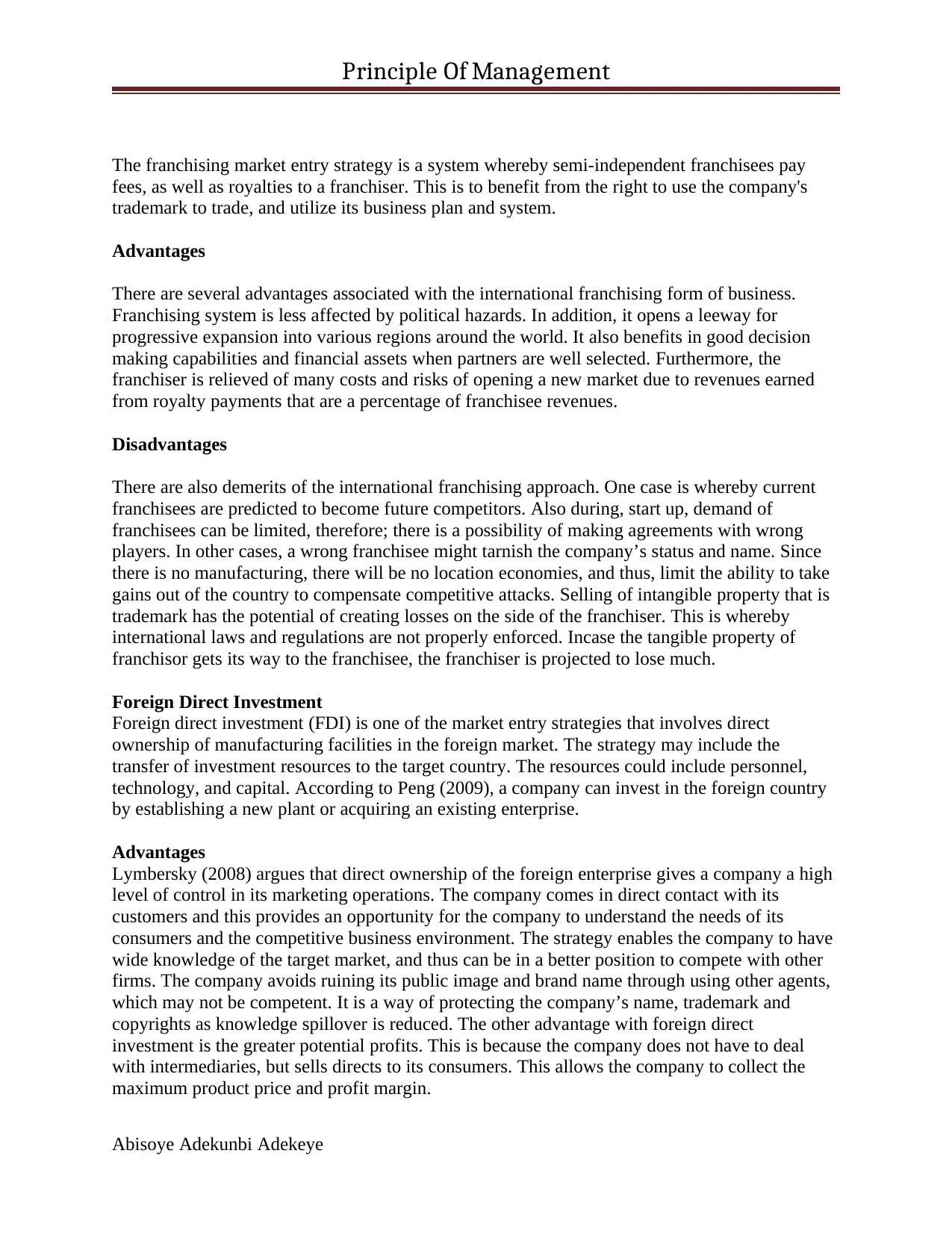
Principle Of Management
The franchising market entry strategy is a system whereby semi-independent franchisees pay
fees, as well as royalties to a franchiser. This is to benefit from the right to use the company's
trademark to trade, and utilize its business plan and system.
Advantages
There are several advantages associated with the international franchising form of business.
Franchising system is less affected by political hazards. In addition, it opens a leeway for
progressive expansion into various regions around the world. It also benefits in good decision
making capabilities and financial assets when partners are well selected. Furthermore, the
franchiser is relieved of many costs and risks of opening a new market due to revenues earned
from royalty payments that are a percentage of franchisee revenues.
Disadvantages
There are also demerits of the international franchising approach. One case is whereby current
franchisees are predicted to become future competitors. Also during, start up, demand of
franchisees can be limited, therefore; there is a possibility of making agreements with wrong
players. In other cases, a wrong franchisee might tarnish the company’s status and name. Since
there is no manufacturing, there will be no location economies, and thus, limit the ability to take
gains out of the country to compensate competitive attacks. Selling of intangible property that is
trademark has the potential of creating losses on the side of the franchiser. This is whereby
international laws and regulations are not properly enforced. Incase the tangible property of
franchisor gets its way to the franchisee, the franchiser is projected to lose much.
Foreign Direct Investment
Foreign direct investment (FDI) is one of the market entry strategies that involves direct
ownership of manufacturing facilities in the foreign market. The strategy may include the
transfer of investment resources to the target country. The resources could include personnel,
technology, and capital. According to Peng (2009), a company can invest in the foreign country
by establishing a new plant or acquiring an existing enterprise.
Advantages
Lymbersky (2008) argues that direct ownership of the foreign enterprise gives a company a high
level of control in its marketing operations. The company comes in direct contact with its
customers and this provides an opportunity for the company to understand the needs of its
consumers and the competitive business environment. The strategy enables the company to have
wide knowledge of the target market, and thus can be in a better position to compete with other
firms. The company avoids ruining its public image and brand name through using other agents,
which may not be competent. It is a way of protecting the company’s name, trademark and
copyrights as knowledge spillover is reduced. The other advantage with foreign direct
investment is the greater potential profits. This is because the company does not have to deal
with intermediaries, but sells directs to its consumers. This allows the company to collect the
maximum product price and profit margin.
Abisoye Adekunbi Adekeye
The franchising market entry strategy is a system whereby semi-independent franchisees pay
fees, as well as royalties to a franchiser. This is to benefit from the right to use the company's
trademark to trade, and utilize its business plan and system.
Advantages
There are several advantages associated with the international franchising form of business.
Franchising system is less affected by political hazards. In addition, it opens a leeway for
progressive expansion into various regions around the world. It also benefits in good decision
making capabilities and financial assets when partners are well selected. Furthermore, the
franchiser is relieved of many costs and risks of opening a new market due to revenues earned
from royalty payments that are a percentage of franchisee revenues.
Disadvantages
There are also demerits of the international franchising approach. One case is whereby current
franchisees are predicted to become future competitors. Also during, start up, demand of
franchisees can be limited, therefore; there is a possibility of making agreements with wrong
players. In other cases, a wrong franchisee might tarnish the company’s status and name. Since
there is no manufacturing, there will be no location economies, and thus, limit the ability to take
gains out of the country to compensate competitive attacks. Selling of intangible property that is
trademark has the potential of creating losses on the side of the franchiser. This is whereby
international laws and regulations are not properly enforced. Incase the tangible property of
franchisor gets its way to the franchisee, the franchiser is projected to lose much.
Foreign Direct Investment
Foreign direct investment (FDI) is one of the market entry strategies that involves direct
ownership of manufacturing facilities in the foreign market. The strategy may include the
transfer of investment resources to the target country. The resources could include personnel,
technology, and capital. According to Peng (2009), a company can invest in the foreign country
by establishing a new plant or acquiring an existing enterprise.
Advantages
Lymbersky (2008) argues that direct ownership of the foreign enterprise gives a company a high
level of control in its marketing operations. The company comes in direct contact with its
customers and this provides an opportunity for the company to understand the needs of its
consumers and the competitive business environment. The strategy enables the company to have
wide knowledge of the target market, and thus can be in a better position to compete with other
firms. The company avoids ruining its public image and brand name through using other agents,
which may not be competent. It is a way of protecting the company’s name, trademark and
copyrights as knowledge spillover is reduced. The other advantage with foreign direct
investment is the greater potential profits. This is because the company does not have to deal
with intermediaries, but sells directs to its consumers. This allows the company to collect the
maximum product price and profit margin.
Abisoye Adekunbi Adekeye
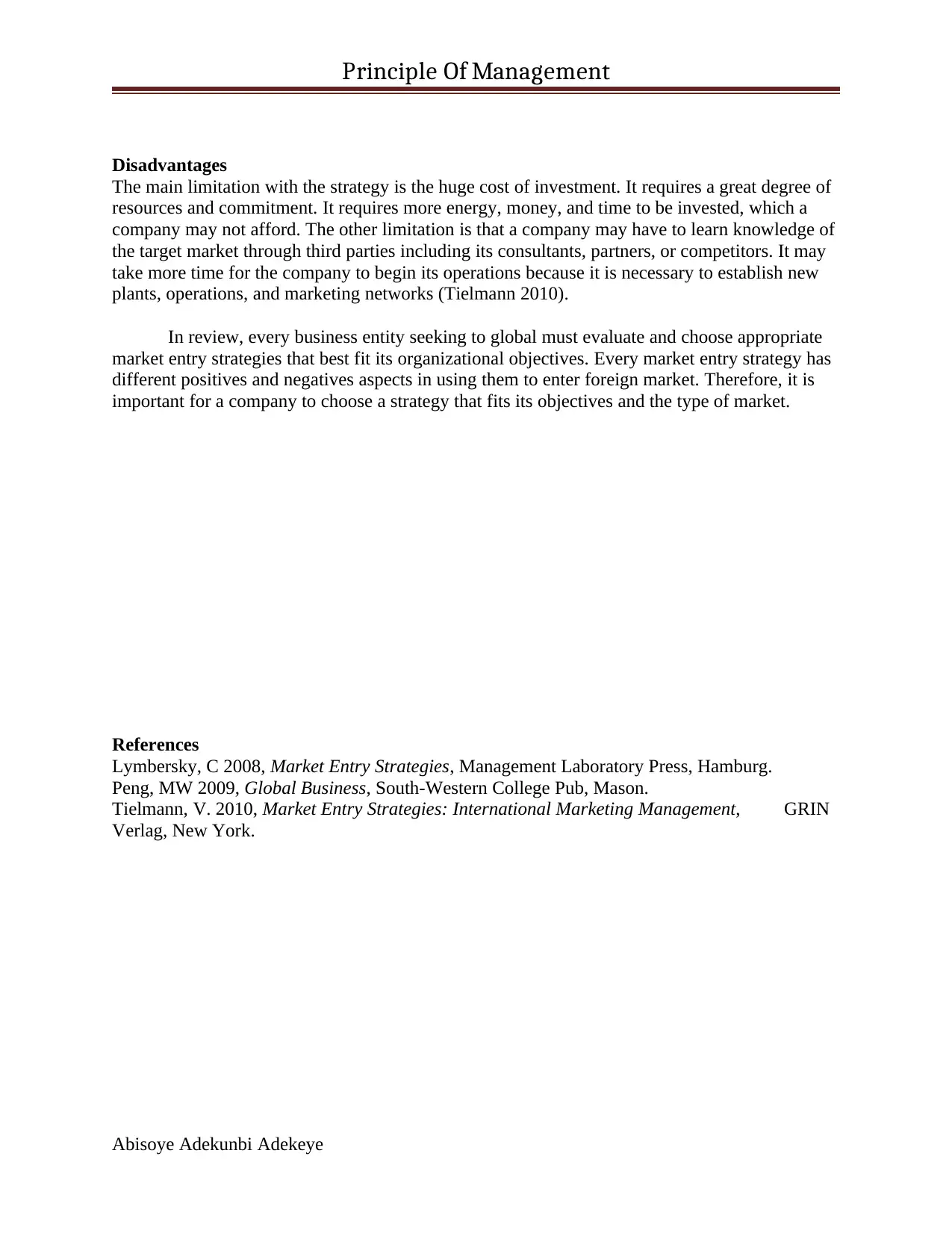
Principle Of Management
Disadvantages
The main limitation with the strategy is the huge cost of investment. It requires a great degree of
resources and commitment. It requires more energy, money, and time to be invested, which a
company may not afford. The other limitation is that a company may have to learn knowledge of
the target market through third parties including its consultants, partners, or competitors. It may
take more time for the company to begin its operations because it is necessary to establish new
plants, operations, and marketing networks (Tielmann 2010).
In review, every business entity seeking to global must evaluate and choose appropriate
market entry strategies that best fit its organizational objectives. Every market entry strategy has
different positives and negatives aspects in using them to enter foreign market. Therefore, it is
important for a company to choose a strategy that fits its objectives and the type of market.
References
Lymbersky, C 2008, Market Entry Strategies, Management Laboratory Press, Hamburg.
Peng, MW 2009, Global Business, South-Western College Pub, Mason.
Tielmann, V. 2010, Market Entry Strategies: International Marketing Management, GRIN
Verlag, New York.
Abisoye Adekunbi Adekeye
Disadvantages
The main limitation with the strategy is the huge cost of investment. It requires a great degree of
resources and commitment. It requires more energy, money, and time to be invested, which a
company may not afford. The other limitation is that a company may have to learn knowledge of
the target market through third parties including its consultants, partners, or competitors. It may
take more time for the company to begin its operations because it is necessary to establish new
plants, operations, and marketing networks (Tielmann 2010).
In review, every business entity seeking to global must evaluate and choose appropriate
market entry strategies that best fit its organizational objectives. Every market entry strategy has
different positives and negatives aspects in using them to enter foreign market. Therefore, it is
important for a company to choose a strategy that fits its objectives and the type of market.
References
Lymbersky, C 2008, Market Entry Strategies, Management Laboratory Press, Hamburg.
Peng, MW 2009, Global Business, South-Western College Pub, Mason.
Tielmann, V. 2010, Market Entry Strategies: International Marketing Management, GRIN
Verlag, New York.
Abisoye Adekunbi Adekeye
⊘ This is a preview!⊘
Do you want full access?
Subscribe today to unlock all pages.

Trusted by 1+ million students worldwide
1 out of 6
Related Documents
Your All-in-One AI-Powered Toolkit for Academic Success.
+13062052269
info@desklib.com
Available 24*7 on WhatsApp / Email
![[object Object]](/_next/static/media/star-bottom.7253800d.svg)
Unlock your academic potential
Copyright © 2020–2025 A2Z Services. All Rights Reserved. Developed and managed by ZUCOL.





